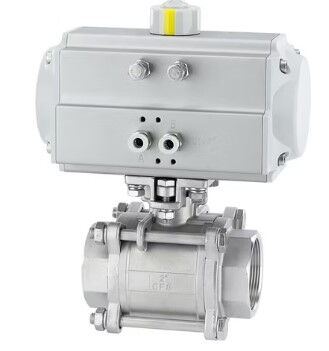Magpie Valve Selection: Accurate Matching Ensures Reliable Control
Valve Technology Sharing
Fast Shut-Off and Vibration Control in Pneumatic Ball Valves
Quick-Action Pneumatic Ball Valve Design: Achieving Second-Level Shut-Off with Pipeline Vibration Suppression
Size Range: DN80, DN100 – suitable for medium to small branch pipelines (e.g., equipment inlets/outlets, process sub-lines).
Actuation Time: Full open/close cycle in 1–2 seconds – significantly faster than standard pneumatic ball valves (3–5 seconds), meeting "emergency shut-off" requirements.
Special Accessories:
Air-Operated Directional Valve: Multi-way air pilot valves (e.g., 5-port air valves) replace traditional single solenoid valves, enabling precise control of cylinder air pathways and eliminating switching delays (reduced from 0.3s to <0.1s).
Quick Exhaust Valve: Integrated at the cylinder exhaust port to release backpressure rapidly, doubling exhaust efficiency (e.g., DN100 cylinder exhaust time reduced from 1.5s to 0.6s).
Optimized Power Transmission:
Cylinder Sizing: Uses double-acting large-bore cylinders (e.g., φ100mm for DN100) with 40% more thrust under high pressure differential (e.g., 8 bar), ensuring rapid movement against fluid resistance.
Air Circuit Design: A direct-flow path via air valve + quick exhaust valve: full inlet pressure fills the rodless chamber on opening; rapid venting of the rod chamber on closing eliminates backpressure drag.
Key Formula: Cylinder volume × flow path diameter². Quick exhaust valves have 1.5× larger diameter than standard exhaust ports.

High-Risk Media Isolation: Effective for natural gas, LPG, and aggressive chemical pipelines. Fast shut-off in 1–2 seconds reduces leakage volume by over 90% compared to 5-second closures (3× less leakage).
Process Interlock Protection: Triggers auto shut-off in case of abnormal pressure/flow (e.g., overpressure, surges), preventing reactor overpressure or pump damage.
Ideal for frequent switching applications (e.g., food filling, pharmaceutical dosing). Rated for over 500 cycles/day, with a lifespan of 500,000 cycles (vs. 300,000 for conventional valves), reducing downtime and replacement frequency.
Mechanism: When closing time t < a·2L (L = pipeline length; a = fluid acoustic velocity, ~1000m/s for water), fluid momentum converts into pressure surges (2–4× working pressure), causing hammer-like pipe vibration.
Example: In DN100 pipe at 3 m/s, a 1-second shut-off generates a 6 bar surge (on top of 1 bar working pressure = 7 bar impact).
As the ball approaches closure, the narrowing gap forms high-velocity jets (>20 m/s), causing turbulence, especially severe with bubbles/particles, increasing vibration intensity by 50%.
Thin-walled pipes (<3 mm) or long support intervals (>5 m) fail to absorb vibration energy, amplifying resonance. E.g., increasing support spacing from 4m to 6m doubles vibration displacement.
Adjustable Throttling: Install precision throttle valves on inlet ports to extend actuation to 2–3 seconds. This reduces water hammer by 60%, suitable for non-explosive emergency scenarios.
Damping Rings: Add nylon buffer rings to the ball core to slow closing speed (e.g., 2 m/s → 0.5 m/s), reducing impact noise by 15 dB.
Staged Shut-Off (Custom Option): Use pilot valve + main valve configuration: the pilot closes first to pre-throttle flow (80% reduction), then the main valve completes the shut-off (total time ~3 seconds), eliminating water hammer in high-speed gas flows (>15 m/s).
Water Hammer Arrestors: Install gas-bag type absorbers 1–2 pipe diameters upstream to absorb surges (keeps surge pressure ≤1.5× working pressure).
Orifice Pre-Throttlers: Add perforated plates upstream (70% open area) to reduce flow by 30% (e.g., 3 m/s → 2.1 m/s), cutting surge energy with negligible pressure drop (<0.05 MPa).
Support Reinforcement:
Use spring-damping supports (±3 mm displacement allowed), and design support spacing as L ≤ 4D (e.g., DN100 → ≤400 mm).
Add heavy-duty limit supports within 1 meter of the valve using channel steel to prevent axial displacement (5× stiffness increase).
Media Type Recommended Shut-Off Time Required Anti-Vibration Measures Prohibited Conditions (High Vibration Risk)
Clean Water / Low Viscosity ≥ 2 sec Hammer arrestor + spring supports Long pipelines (>50 m) + high velocity (>3 m/s)
Gas / Compressed Air 1–2 sec (pre-throttle) Orifice plate + bellows compensators High-speed gas (>20 m/s)
Particle-Laden / Viscous Fluids ≥ 3 sec Wear-resistant trim + extended support spacing (3 m) Particle size >1 mm + flow velocity >2 m/s
Dry Run: Test without fluid using stopwatch to verify actuation time (±0.2 sec margin). Check for smooth motion, any stalling may indicate future impact issues under load.
Live Test: Gradually raise flow rate and use vibration meter to monitor acceleration near the valve (safe threshold <15 m/s²; if exceeded, install damping solutions immediately).
Quick Exhaust Valve Cleaning: Monthly removal and cleaning of internal filters to prevent water scale buildup (especially in humid environments; blockages extend actuation to >3 seconds).
Seal Inspection of Air Valves: Regularly check for air leaks at connections to maintain full cylinder thrust and consistent shut-off speed.
Support Bolt Tightening: Quarterly inspection with torque wrench (recommended: M12 → 40 N·m, M16 → 75 N·m) to prevent vibration-induced loosening.
Second-level actuation in pneumatic ball valves is a critical safety asset, designed to "win the golden moment" during emergencies. However, such speed must be paired with precise engineering and scenario matching to avoid secondary vibration risks.
Core Principle: It's not about going faster; it's about being fast enough and smart. Match shut-off time to media speed and pipe layout, and apply targeted vibration controls. With this approach, 95% of conditions can achieve safe, damage-free rapid shut-off.
Pro Tip: When selecting valves, always provide the supplier with media type + flow velocity + pipeline layout drawings to avoid secondary risks from the start, ensuring you get both efficiency and stability.